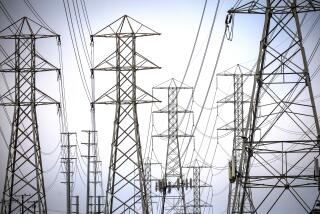ENERGY DRAIN
When devices such as stereos are turned off, we think of them as dead. But it turns out theyâre only mostly dead. And mostly dead is a little bit alive.
For instance, have you ever wondered how a television set can understand the âpower onâ command from the remote control if the TV isnât using any power at all? The fact is nearly all television sets--in fact, most home appliances--use power as long as theyâre plugged in to a live electrical outlet, if only to receive and interpret remote control signals or keep the little clock running.
All those little trickles of electricity can add up to a steady stream of juice that users end up paying for--power thatâs being drained from a system that canât meet the stateâs needs as California enters a summer of rolling blackouts and rising power bills. Plus, the delicate electronic circuitry that makes our favorite gizmos work can be damaged when the power flow abruptly stops and starts.
Researchers refer to this sort-of-off-but-sort-of-on condition as âstandby powerâ and say the drain on the electrical supply is significant--and continuing to rise.
âWhen you add up all these things like TVs and VCRs, it looks like standby use in California is almost 10% of the residential use of electricity,â said Alan Meier, staff scientist at the Berkeley Laboratory and an internationally recognized expert on the phenomenon of standby power drain.
The cost of this drain probably isnât especially onerous to most consumers. Leaving your answering machine plugged in all the time, for instance, will cost you about 37 cents a month, assuming youâre paying about 17 cents a kilowatt-hour.
The total cost of standby power probably is in the neighborhood of $100 a year per household at current rates, though that figure will rise as electricity becomes more expensive. Though thatâs not a vast sum to many people, reducing electricity usage is critical to maintaining a steady power supply in California.
The difference between a Stage 2 power emergency and Stage 3--the point at which rolling blackouts kick in--is only 3.5% of total reserve electrical capacity. So cutting back on that leaking 10% in homes can make the difference.
Not all the standby power is wasted. An answering machine is pretty useless if it doesnât have access to power all the time since part of the deviceâs job is to be primed to pick up the phone if it should ring. Itâs those other devices, such as the microwave oven clock that pulls power even though nothingâs being cooked, that are the problem. All devices that use standby power could be designed to use as little electricity as possible.
Standby power drain is getting worse as more of the items we have in our homes move from mechanical switches and timers to electronic controls. The typical household today uses 7,000 kilowatt-hours of power each year.
Overall, residential consumption of power has risen 17.6%, from 68,000 gigawatt-hours in 1990 to an estimated 80,000 gigawatt-hours, according to the California Energy Commission. Even when adjusted for population growth, Californians use more power than they did 10 years ago--despite the fact that household appliances got more energy efficient.
One reason: Weâve got a lot more energy-gobbling devices in our homes. For instance, Fred Johnson, who works in Silicon Valleyâs high-tech industry, has three TVs, each with a DVD player. Heâs also got two TiVo digital recorder boxes, four computers and two stereo systems.
âFortunately, itâs not all on simultaneously,â he said.
Another reason for the increase in power draw is a simultaneous increase in the number of devices that are always on. For instance, older microwave ovens used a mechanical timer, which means the device didnât draw power unless the oven was actually heating something up. Newer ovens use electronic touch pads and digital clocks, both of which require a steady stream of power. Part of the reason for the shift was interest in reliability; mechanical switches wear out or need maintenance, whereas electronic controls are generally service free.
Those digital controls are showing up in things such as stoves, dishwashers, washers and dryers, which means these devices also leak electricity even when theyâre not actually working.
Some devices are so badly designed that they generally use as much electricity when theyâre theoretically off as when theyâre on, Meier said. âThe set-top boxes for cable and satellite television broadcasts are good examples,â he said. Manufacturers arenât under any pressure to improve the design of electronic components in the home because thereâs no financial incentive for them to do so.
Consumers wind up paying the price.
âWe think there are typically 20 devices in a home that are consuming standby power,â Meier said. âIn the average home in California, standby power is somewhere around 500 kilowatt-hours a year. And some users are paying 20 cents a kilowatt. So thatâs about $100 a year for appliances that arenât actually doing what you bought them for.â
That hundred bucks during the course of a year might seem a pretty small price to pay for the ability to change the music coming out of the CD player without having to lever yourself off the couch.
But even if it does bother you, thereâs not a lot you can do, short of unplugging devices when theyâre not in use. Sometimes unplugging a device isnât practical, though, because many components will lose information stored in them if the power goes out. Your radio might forget its presets, your VCR will lose the time and some TVs will have to be reprogrammed with the local television stations available.
On a fundamental level, this is an issue that has to be addressed by electronics manufacturers, who, until now, largely ignored the issue. Meier has been leading a fight during the last couple of years to get manufacturers to build devices that use standby power more efficiently, to keep that functionality but make better use of electricity.
âSome of these devices draw 15 or 20 watts,â Meier said. New designs can reduce that flow to 1 watt, but few manufacturers have shown enthusiasm for the goal. That might change as governments put pressure on manufacturers. Australia, for one, recently endorsed the goal of 1-watt standby drain for all appliances.
In addition, there is some concern that, under certain conditions, devices that draw power all the time could be slightly more vulnerable to damage caused by fluctuations in the power supply than devices that are completely powered down.
If thatâs true, it makes such things as surge suppressors and uninterruptible power supplies even more important to consumers at a time when rolling blackouts are expected to become a regular occurrence.
Surge suppressors are designed to choke off a spike of electricity before it can reach your valuable components and damage them. Typically, a lightning strike a mile or so away can flow down electric, telephone or cable television wires and fry any component connected to the line, such as a home computer. The surge suppressor intercepts that overload.
These surges can occur in many different situations, such as apartment buildings where large motors--for instance, those used in air conditioners and elevators--routinely go on and off.
âAny time the power goes off and goes back on again, thatâs a tremendous hit on the electrical system, and that can cause surges,â said John Drengenberg, an electrical engineer whoâs manager of global consumer affairs for Underwriters Laboratories, the nonprofit testing organization. âI think maybe right now in California, in particular, installing transient voltage surge suppressors would be a good idea.â
Surge suppressors donât help at all with a brownout, which is an insufficient flow of electricity through the wires.
Brownouts are most often caused by things such as a squirrel shorting out a line and can be identified by suddenly dimmed lights. Low voltage can seriously damage appliances that use motors--such as refrigerators and air conditioners--so if the lights go dim and stay dim, unplug such appliances until the power company makes repairs.
Items that use electricity to create heat or produce light will continue to function with little chance of damage; they just wonât get as hot or be as bright.
Some devices, such as computers, will get trashed by low power or sudden loss of power, especially if the power fluctuates while the system is writing data to the hard drive. Computers should be turned off using the standard shutdown procedure for their particular make and model to avoid corruption of the operating system, which can create lots of headaches for users.
To avoid that, consider an uninterruptible power supply, basically just a system of rechargeable batteries thatâs always plugged in to the electrical outlet. Plug the components into the UPS, and if the voltage on the line drops or disappears, the juice flows from the batteries to the device.
Many of these systems also come with surge suppressors built in as well, protecting equipment from both too much and too little electricity. A high-end consumer UPS costs less than $200.
Most of these systems are designed to safely power down a computer in the event of a power outage. They wonât provide enough juice for more than a few minutes on a standard desktop computer.
And of course, the debate about whether some conservation efforts have diminishing returns continues. Turning off your computer reduces electricity consumption, but repeatedly turning the computer off and on can stress the electronic circuitry, which could cause it to fail sooner.
Devices that are pulling down considerably less electricity might eke out an hour or two on a UPS. If you find yourself growing increasingly annoyed at having to reset the clock on the VCR or microwave, a consumer-level UPS might provide enough stored power to get you through a blackout that lasts an hour or two.
Donât plan on watching TV or making popcorn. Weâre talking strictly about keeping the clock on line, although most people probably wonât be interested. âSpending $150 because you donât want to set the clock on the VCR probably wonât be very appealing to many people,â said James Little, a spokesman for Belkins Components, which makes such devices.
And thereâs no such thing as a free lunch. UPS systems are also a drain on power. It costs money to keep the batteries charged in preparation for the blackout. So donât look to a UPS as a solution to conservation.
What you can do is plug components that can safely be completely shut down into a surge suppressor and kill the power to that surge suppressor when youâre not using them.
For instance, think about running all the power cords for every component that makes up your stereo system--amplifier, CD player, DVD player--into a single power strip equipped with a surge suppressor. Most surge suppressors have a kill switch, a button that will cut off all power to the devices plugged into it.
Hit the switch and make those components more than mostly dead.
*
Dave Wilson is The Timesâ personal technology columnist.
(BEGIN TEXT OF INFOBOX / INFOGRAPHIC)
Standby Power Consumption Ranges
Most modern electronics--televisions, stereos, VCRs, microwave ovens--draw power even when theyâre technically off, usually to keep the clock running or to keep the device awake so that it can respond to commands from a remote control.
Although nobody wants to eliminate the convenience of remote control, manufacturers are coming under increasing pressure to improve the efficiency of household appliances that consume power in standby mode. The goal is to get each deviceâs standby power consumption under 1 watt. As the chart shows, manufacturers have a long way to go.
*
More to Read
Inside the business of entertainment
The Wide Shot brings you news, analysis and insights on everything from streaming wars to production â and what it all means for the future.
You may occasionally receive promotional content from the Los Angeles Times.










